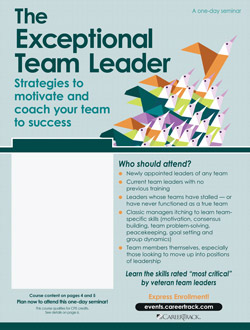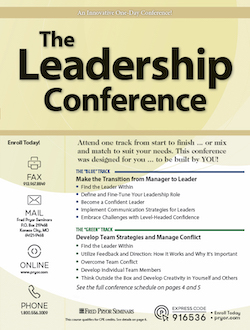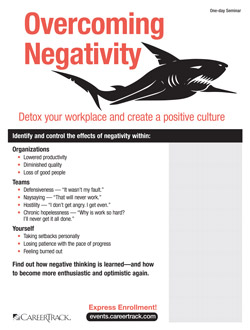Personal Leadership Development Plan
- Author: Pryor Learning
- Categories:
- Tags:
- Share on:
You do what you plan.
All of us, whether in business or everyday life, are more likely to accomplish a task if we first create a plan. Leadership and personal development coach, Michael Hyatt, shares that writing down those goals helps you clarify your intentions, motivates you to take action and gets you through distractions and roadblocks.[1]
If you want to improve leadership skills to take your team to the next level or to get you that promotion, create a Leadership Development Plan. It is especially helpful if you find it difficult to make time for professional development amid the crush of accomplishing your work each day.
Below are tips for creating your own Leadership Development Plan:
Prepare a Vision Statement
Before you set any dates or sign up for any classes, spend the time to understand what you are working towards. Your leadership vision statement should be a simple but inspiring summary that answers these questions:
- What do you want to create for yourself and others around you?
- What type of leader do you want to be?
- How do you want to think and feel about your work?
- What are your professional goals?[2]
To inspire you read Personal Mission Statements of 5 Famous CEOs.
Assess Your Needs
Write down a list of the qualities and competencies you see in a good leader. Include traits that are specific to your current or desired work environment. Then, evaluate your proficiency at each, marking both strengths and areas that need development.
Brainstorm solutions to the problems that are specific to your organization and identify new skills needed to execute those solutions. If communication is an issue on your team, you may need to improve your conflict resolution skills or ask for advice on the best ways to incentivize communication processes.
Kelli Richards, CEO at The All Access Group, LLC also recommends seeking the counsel of trusted advisors – what she calls gurus – during the assessment stage to add credibility and accountability to your plan.[3]
Create Metrics for Success
Use your list of desired leadership qualities and generate a metric for what competency in that skill looks like. Again, connect the skills with results in your current work environment. If excellent communication is on your list, then set a metric of “errors and personal issues generated by miscommunication are down 75%”. If being able to delegate tasks appropriately is a personal goal, then your metric might be “I am spending 95% of my time on tasks that only I can perform”.
Generate a List of Opportunities
Brainstorm challenges that you will undertake to push your skills and increase your influence. Does your company participate in a charity drive every year? Do you know of a new account coming to your group, soon? By identifying opportunities that challenge you in the ways you identify as important to your personal leadership development plan, you are more prepared to take them on and be less likely to add responsibilities that aren’t in line with your goals.
Maintain
You will achieve both success and failure as you execute your plan. This is why it is important to re-evaluate periodically to ensure that your needs, metrics and opportunities remain in sync. Or you may decide that your vision for your future has changed and a whole new plan is necessary. Give yourself permission to adjust and refine. Just remember to write your new goals down when you do.
[1] http://michaelhyatt.com/5-reasons-why-you-should-commit-your-goals-to-writing.html
[2]https://www.sgim.org/File%20Library/SGIM/Resource%20Library/Meeting%20Handouts/ACLGIM/2012/Hess.pdf
[3] http://www.inc.com/kelli-richards/3-essential-steps-to-creating-a-successful-personal-growth-plan.html
Choose a Seminar and Save $10
Styles & Strategies to Supervise Effectively
1 Day
- CEU: 0.6
- CPE: 6
Team Training - Virtual or In-person

Spark Innovation and Think Strategically
1 Day
- CEU: 0.6
- CPE: 6
Team Training - Virtual or In-person

How to Manage Remote Employees
1 Day
- CEU: 0.6
- CPE: 6
- HRCI: 5.5
- PDC: 6
Team Training - Virtual or In-person
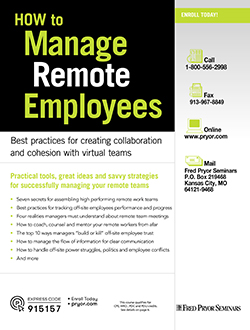
How to Supervise People
1 Day
- CEU: 0.6
- CPE: 6
- PDC: 6
Virtual Seminars:
-
Apr 17
-
Apr 22
-
Apr 24
-
+ 25 more dates
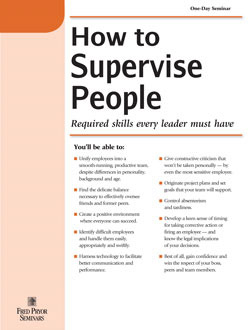
Facilities Management - A 2-Day Comprehensive Course
2 Days
- CEU: 1.2
- CPE: 12
Virtual Seminars:
-
Apr 23-24
-
Apr 29-30
-
May 1-2
-
+ 24 more dates
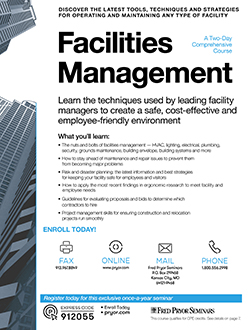
Managing with Assertive Confidence
1 Day
- CEU: 0.6
- CPE: 6
Virtual Seminars:
-
Apr 22
-
May 8
-
May 13
-
+ 2 more dates

Leadership, Team-Building and Coaching Skills for Managers and Supervisors
1 Day
- CEU: 0.6
- CPE: 6
- HRCI: 5.5
- PDC: 6
- PDU: 6
Virtual Seminars:
-
Apr 17
-
Apr 18
-
Apr 22
-
+ 40 more dates
In-Person Events:
- Apr 22, Indianapolis, IN
- Apr 23, Chicago, IL
-
+ 19 more dates

Transitioning to Supervisor
1 Day
- CEU: 0.6
- CPE: 6
Virtual Seminars:
-
Apr 17
-
Apr 18
-
Apr 22
-
+ 41 more dates
In-Person Events:
- Apr 22, Phoenix, AZ
- Apr 23, Ontario, CA
-
+ 14 more dates
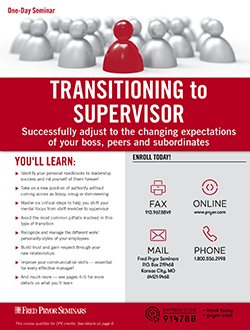
Leadership & Management Skills for Women
1 Day
- CEU: 0.6
- CPE: 6
Virtual Seminars:
-
Apr 17
-
Apr 29
-
May 7
-
+ 8 more dates
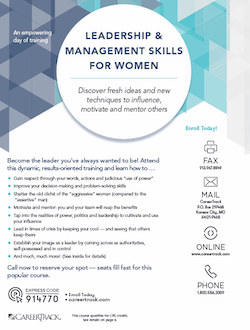
How to Supervise Bad Attitudes and Negative Behaviors
1 Day
- CEU: 0.6
- CPE: 6
- HRCI: 5.5
- PDC: 6
Virtual Seminars:
-
Apr 17
-
Apr 22
-
Apr 25
-
+ 18 more dates

Management & Leadership Skills for New Managers and Supervisors (2-Day)
2 Days
- CEU: 1.2
- CPE: 12
Virtual Seminars:
-
Apr 17-18
-
Apr 22-23
-
Apr 24-25
-
+ 32 more dates
In-Person Events:
- Apr 29-30, Denver, CO
- May 1-2, Portland, OR
-
+ 20 more dates

How Managers Become Great Leaders
1 Day
- CEU: 0.6
- CPE: 6
Virtual Seminars:
-
Apr 17
-
Apr 18
-
Apr 23
-
+ 16 more dates
In-Person Events:
- Jul 22, Nashville, TN
- Jul 25, Las Vegas, NV

A Crash Course for the First-Time Manager or Supervisor
1 Day
- CEU: 0.6
- CPE: 6
- HRCI: 5.5
- PDC: 6
Virtual Seminars:
-
Apr 18
-
Apr 22
-
Apr 24
-
+ 27 more dates
In-Person Events:
- Jun 13, Phoenix, AZ
- Jun 18, New York, NY
-
+ 2 more dates

Criticism & Discipline Skills for Managers and Supervisors
1 Day
- CEU: 0.6
- CPE: 6
- HRCI: 5.5
- PDU: 6
Virtual Seminars:
-
Apr 23
-
May 6
-
May 15
-
+ 13 more dates

The Indispensable Office Manager
1 Day
- CEU: 0.6
- CPE: 6
Virtual Seminars:
-
Apr 23
-
May 1
-
May 6
-
+ 5 more dates
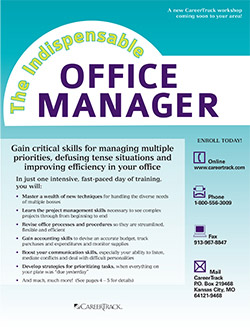
Be the Manager Your Employees Want to Follow
1 Day
- CEU: 0.6
- CPE: 6
- PDC: 6
Virtual Seminars:
-
May 5
-
May 8
-
May 14
-
+ 5 more dates
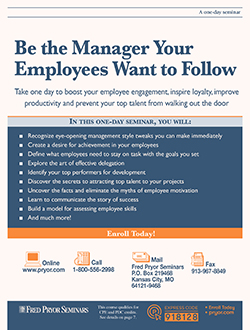
How to Improve Employee Accountability with Remote and In-Person Teams
1 Day
- CEU: 0.6
- CPE: 6
- PDU: 6
Virtual Seminars:
-
Jun 3
-
Jun 9
-
Jun 18
-
+ 5 more dates

The Exceptional Team Leader
1 Day
- CEU: 0.6
Virtual Seminars:
-
Jun 3
-
Jun 9
-
Jun 18
-
+ 5 more dates
